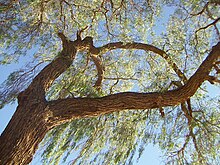Prosopis tamarugo
| Prosopis tamarugo | |
|---|---|

| |
| Scientific classification | |
| Kingdom: | Plantae |
| Clade: | Tracheophytes |
| Clade: | Angiosperms |
| Clade: | Eudicots |
| Clade: | Rosids |
| Order: | Fabales |
| Family: | Fabaceae |
| Subfamily: | Caesalpinioideae |
| Clade: | Mimosoideae |
| Genus: | Prosopis |
| Species: | P. tamarugo
|
| Binomial name | |
| Prosopis tamarugo | |
Prosopis tamarugo, commonly known as tamarugo, is a species of flowering tree in the pea family, Fabaceae. It is found only in the dry northern regions of Chile.
Description
[change | change source]Prosopis tamarugo are trees that could grow up to 30 m (98 ft) tall but usually they are, on average, 15 m (49 ft) tall and the trunk is 50–80 cm (20–31 in) wide. The young branches have spines. Flowers grow together in inflorescences and their pollination is made by bees.[2]
Where it grows
[change | change source]The plant grows only in the Pampa del Tamarugal, some 70 km (43 mi) east of the city of Iquique.
The Pampa del Tamarugal is a plain between 19°33' S and 21°50' S, and an altitude from 300 to 1,200 km (190 to 750 mi).[2]
Even if the Pampa del Tamarugal is very dry, the Prosopis tamarugo can use the relatively shallow ground water.[3]
Uses
[change | change source]The wood and dry leaves of Prosopis tamarugo are used as firewood; the wood is also used for lumber. Leaves and fruits are used as food to animals, mainly to ruminants as cattle, sheep and goats.[2]
Fruits are sweet and people can eat them.
Gallery
[change | change source]-
Leaves
-
Fruits
References
[change | change source]- ↑ González, M. (1998). "Prosopis tamarugo". IUCN Red List of Threatened Species. 1998: e.T32037A9676582. doi:10.2305/IUCN.UK.1998.RLTS.T32037A9676582.en. Retrieved 16 May 2020.
- ↑ 2.0 2.1 2.2 Habit, Mario a. (1980). Prosopis tamarugo: Arbusto forrajero para zonas áridas (in Spanish). FAO. ISBN 92-5-301055-X. Retrieved 26 August 2016.
- ↑ Mooney, HA; Sl Gulmon; PW Rundel; J Ehleringer (1980). "Further observations on the water relations ofProsopis tamarugo of the northern Atacama desert". Oecologia. 44 (2): 177–180. Bibcode:1980Oecol..44..177M. doi:10.1007/bf00572676. JSTOR 4216007. PMID 28310553. S2CID 7485836. Retrieved 26 August 2016.



